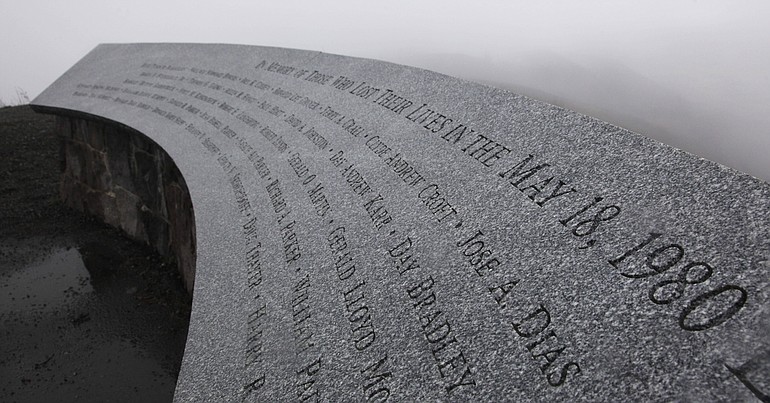Editor’s note: This is the latest installment in a series about the 30th anniversary of the the eruption of Mount St. Helens. See special features, including reader memories and Columbian coverage at www.columbian.com/volcano.
JOHNSTON RIDGE OBSERVATORY — Visitors gathered beneath a gray, overcast sky to commemorate the day 30 years ago when Mount St. Helens destroyed what nature almost immediately began to rebuild.
During a moment of silence, it might have seemed possible to hear the faint echo of geologist David A. Johnston’s final dispatch: “Vancouver! Vancouver! This is it.”
Hundreds of people descended Tuesday on the spot where Johnston perished in the eruption on May 18, 1980. Another 56 died that day in the blast zone.
Of all the people who gathered during the 30th anniversary commemoration, none may have known the mountain as thoroughly and as intimately as U.S. Geological Survey retiree Donal Mullineaux.
The Camas native first climbed the volcano in 1946 and scaled it several times through the early 1950s.
“I climbed it many times,” he said. “It was a gorgeous mountain; I thought it was prettier in 1950.”
It was only later, after he went on to become a professional geologist, that he realized the true danger lurking underneath the conical snow-capped peak.
In 1978, he co-authored a paper with fellow USGS scientist Dwight “Rocky” Crandell laying out the very active eruptive history of Mount St. Helens. That history was fresh enough that the pair characterized Mount St. Helens as a volcano that might erupt again before the turn of the century. Some longtime residents scoffed.
It took just two years for the scientists to be proven right.
A series of earthquakes beginning in March 1980 signaled that magma was on the move. Over the course of the next two months, the north face of the mountain bulged by as much as five feet a day. The USGS dispatched Mullineaux to head up the team of scientists monitoring what had become an active hazard.
The volcano was primed to erupt.
Johnston, a 30-year-old geologist who had previously studied an explosive eruption at the Augustine volcano in Alaska, was on duty the morning of May 18.
“He knew more about an explosive eruption than any of us,” Mullineaux said.
Yet, despite that experience and the accumulated knowledge of scientists who understood the mountain’s violent past, no one fully grasped the possibility of a lateral blast that extended for miles beyond the mountain’s flanks.
Biggest landslide
At 8:32 a.m., a 5.1-magnitude earthquake triggered the biggest landslide in recorded history. The slide uncorked a gas-charged reservoir of magma that flattened 230 square miles of forest, snapping old growth firs like matchsticks; jetted a 15-mile-high plume of ash that eventually circled the globe; and buried the Toutle River valley beneath 150 to 200 feet of eviscerated mountaintop.
“We didn’t envision any kind of distance of the lateral blast,” said Mullineaux, who now lives in the Denver area.
USGS scientist Don Swanson had been dispatched to Vancouver from his normal assignment in Menlo Park, Calif.
At Johnston Ridge on Tuesday, he recalled watching a wildly jiggling seismometer in the Survey’s temporary quarters inside the office of the Gifford Pinchot National Forest in downtown Vancouver. Swanson, who was due to relieve Johnston in the days ahead, tried contacting his colleague to get an assessment.
“After we saw the signal, I ran upstairs and radioed Dave but didn’t get any response,” he said. “It was clear that something very major had happened here.”
Johnston’s final dispatch was only heard later on a recording.
Swanson arranged to get aboard a small airplane that departed Pearson Field shortly after 9 a.m. with a pilot and a Forest Service employee. It quickly became apparent that the mountaintop was gone — the top 1,314 feet of the once-symmetrical peak had been blown away — and the odds of finding survivors would be remote.
He said scientists had known there was a threat of a lateral blast, but they thought it would be less likely than a vertical plume.
“Sometimes, you just have blinders, and you need a lightning bolt to make it clear,” Swanson said.
Within a year or two, he said, scientists began to recognize evidence of similar massive failures in the landforms surrounding some 200 volcanoes across the world. Photographs taken from around Mount St. Helens on that bright blue morning demonstrated vividly that mountains can suddenly fall apart.
Camped nearby
Marianna Kearney was camped out eight miles west of the volcano with her husband, Ty.
The Vancouver couple had been staying in their camper since May 13 as voluntary volcano watchers for Washington emergency managers. A series of her husband’s photographs now hang on the wall at Johnston Ridge.
“I was just awestruck by the whole thing,” she recounted, standing near the exhibit. “I’d never seen anything like that.”
Despite the image of utter devastation, scientists see life everywhere today.
Forest Service ecologist Charlie Crisafulli has studied re-assembled communities of plants and animals returning to the debris-scoured landscape. He calls it an eruption of life, one of the most biologically diverse landscapes on earth.
Scientists are learning how nature rebuilds itself from a blank slate.
“It’s revolutionized our whole view of large disturbance regimes. We are a region of large disturbances,” said Jerry Franklin, a University of Washington ecologist who has studied old growth forests. “This one rubbed our face in it.”
Erik Robinson: 360-735-4551; erik.robinson@columbian.com



